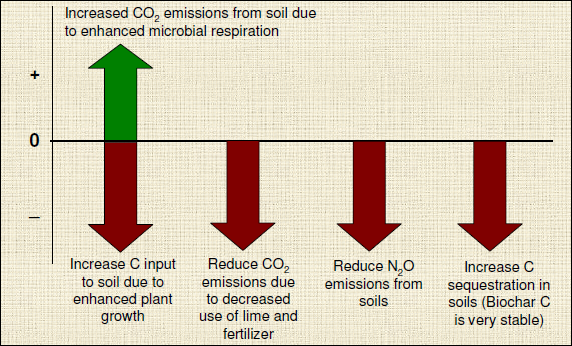बायोचर - कृषि के लिए नया काला सोना
 Agricultural waste is usually handled as a liability, often because the means to transform it into an asset is lacking. These residues are either partially utilized or un-utilized due to various constraints.
Agricultural waste is usually handled as a liability, often because the means to transform it into an asset is lacking. These residues are either partially utilized or un-utilized due to various constraints.
Among the cereal residues, rice and wheat straws are the dominant and the easiest way to clear the field is burning these in the field itself.
By realizing those problems, some previous researchers try to use the more resistant organic matter such as biochar.
Biochar has great importance in improving soil fertility and it could act as a soil amendment to increase crop yield and plant growth by supplying and retaining nutrients than other organic matter such as leaf litter, compost or manure.
Conversion of biowaste to biochar is a potential tool for carbon sequestration and reducing GHG emission.
Biochar is a fine-grained, carbon-rich, porous product remaining after plant biomass has been subjected to thermo-chemical conversion process at high temperatures with little or no oxygen.
The central quality of biochar that makes it attractive as a soil amendment is its highly porous structure, potentially responsible for improved water retention and increased soil surface area.
Because of its aromatic structure dominated by aromatic carbon, biochar has been found to be biochemically recalcitrant compared to uncharred, parent organic matter and have considerable potential to enhance the long term soil carbon pool and a net carbon withdrawal from the atmosphere of 20% (Purakayasthaet al., 2013).
Biochar for soil health enhancement
1. Soil quality and fertility improvement
Biochar application to soil leads to several interactions mainly with soil matrix, soil microbes, and plant roots. The types and rates of interactions depend on different factors like composition of biomass as well as biochar, methods of biochar preparation, physical aspect of biochar and soil environmental condition mainly soil temperature and moisture.
Biochar can act as a soil conditioner by improving the physical and biological properties of soils such as water holding capacity and soil nutrients retention, and also enhancing plant growth.
Table 1. Effect of biochar on different soil properties
| Factor | Impact |  |
| Cation exchange capacity | 50% increase | |
| Bulk density | 13% decrease | |
| Specific surface area | 15% increase | |
| Fertilizer use efficiency | 10-30 % increase | |
| Liming agent | 1 point pH increase | |
| Mycorrhizal fungi | 40 % increase | |
| Biological nitrogen fixation | 50-72% increase |
2. Remediation
Carbonaceous materials such as char and activated carbon have received considerable attention in recent years as soil amendment for both sequestering heavy metal contaminants and releasing essential nutrients like sulphur. Information is currently lacking in how aging impacts the integrity of biochar as soil amendment for both agricultural and environmental remediation purposes.
Biochar has a relatively structured carbon matrix with a medium-to high surface area, suggesting that it may act as a surface sorbent which is similar in some aspects to AC (activated carbon). Black carbon surfaces are porous with apolar and aromatic surfaces.
They have a high surface to volume ratio and a strong affinity to non-polar substances such as polycyclic aromatic hydrocarbons (PAHs), dioxins, furans (PCDD/Fs), PCBs, and PBDEs.
3. Crop productivity
The application of biochar to soil has been shown to improve crop yields which could be due to direct or indirect effect. The direct effect is explained by the fact that biochar being concentrated during pyrolysis contains higher amount of nutrients than the biomass from which they are prepared.
The indirect effect is due to improvement in soil physical, chemical and biological properties due to biochar application.Several workers have reported that biochar applications to soils have shown positive responses for net primary crop production, grain yield and dry matter.
Arifet al. (2012) reported application of biochar at the rate of 30 tones ha-1 in combination with mineral nitrogen at the rate of 75 kg ha-1 is recommended for improving maize productivity.
Application of biochar @ 20 t ha-1 along with 2 per cent PGPR and NPK as per POP recorded the significantly superior yield of 20.12 t ha-1 with B: C ratio of 1.56 and it can be considered as the economically viable. Several workers have reported that biochar applications to soils have shown positive responses for net primary crop production, grain yield and dry matter.
 Sequestering biochar in soil, which makes soil darker in colour is a robust way to store carbon
Sequestering biochar in soil, which makes soil darker in colour is a robust way to store carbon
Biochar for greenhouse gas mitigation
As one major goal of biochar soil amendment is to sequester carbon in order to mitigate climate change, numerous studies addressed the microbial response to biochar addition in terms of emissions of the greenhouse gases N2O, CO2 and CH4 from soil. In comparison to burning, controlled carbonization converts even larger quantities of biomass organic matter into stable C pools which are assumed to persist in the environment over centuries.
The conversion of biomass carbon to biochar leads to sequestration of about 50% of the initial carbon compared to the low amounts retained after burning (3%) and biological decomposition. Lehmann (2007) reported that biochar amendments to soil, when carried out sustainably, may annually sequester an amount of C equal to 12% the current anthropogenic CO2 emissions.
Biochar is reported to reduce N2O emission could be due to inhibition of either stage of nitrification and/or inhibition of denitrification, or promotion of the reduction of N2O, and these impacts could occur simultaneously in a soil.
 Net impact of biochar applications in soil on greenhouse gas emissions
Net impact of biochar applications in soil on greenhouse gas emissions
References
- Arif, M., Ali, A., Umair, M., Munsif, M., Ali, K., Inamullah, Saleem, M., and Ayub, G. 2012. Effect of biochar, fym and mineral nitrogen alone and in combination on yield and yield components of maize. Sarhad J. Agric. 28(2): 191-195.
- Lehmann, J. 2007. A handful of carbon. Nature 447: 143-144.
- Purakayastha, T.J., Pathak, H., and Savita, K. 2013. Stability of biochar carbon -Its implication on carbon sequestration and microbial activities in soil. In: Proc.100th Indian Science Congress, Part II, Abstracts of Oral Presentation, University of Calcutta, Kolkata during Jan. 3-7, 2013. pp. 287-288.
Authors
Durga C*
Department of Agronomy (Water Management) ,
PJTSAU, College of Agriculture, Rajendranagar, Hyderabad–500 030, Telangana, India
* Email:
